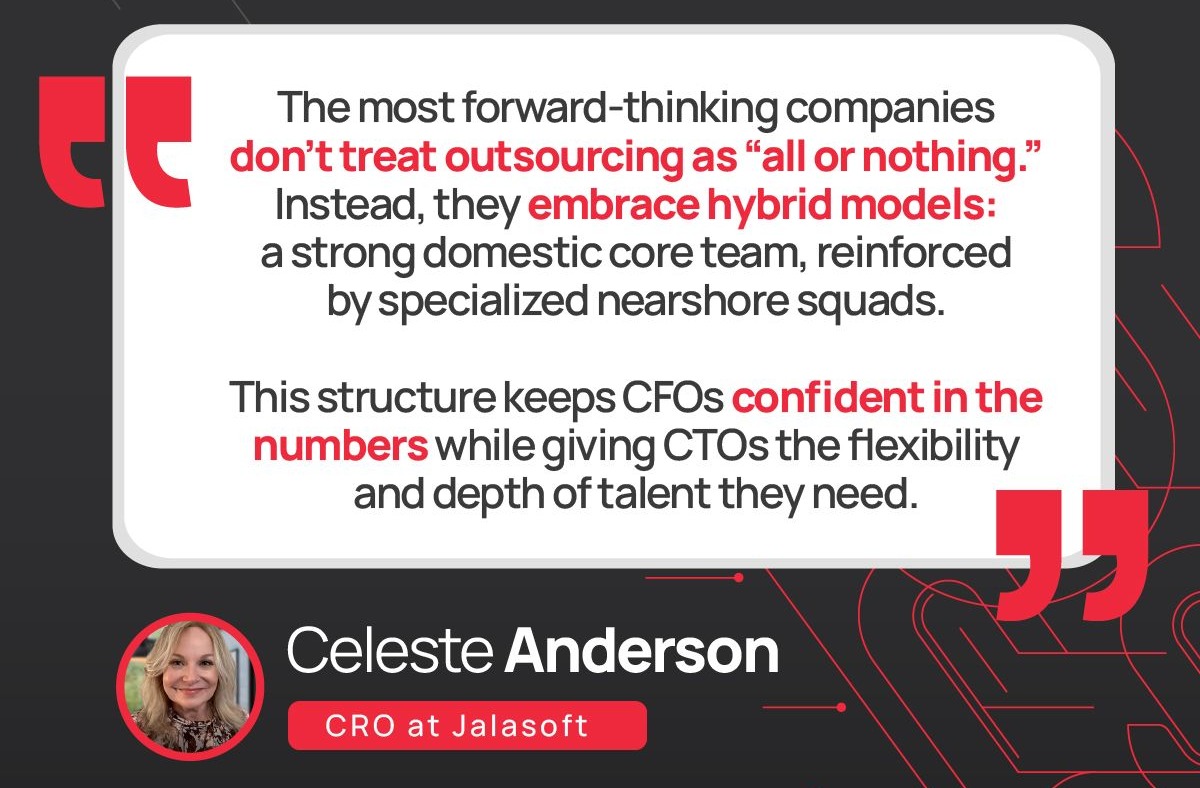Modern engineering teams depend on the right mix of in-house talent and external partners. But deciding between traditional outsourcing and a managed services model is rarely straightforward. Each delivers value differently, and the best choice depends on your product strategy, operational maturity, and long-term scalability goals.
Here’s a practical guide to help tech-led companies choose the model that actually aligns with how they build and ship software.
IT Outsourcing and Managed Services Aren’t the Same — But Most Leaders Treat Them As If They Are
Many tech-led companies see outsourcing and managed services as interchangeable options for relieving pressure on internal teams. That assumption quietly creates misalignment before a partner even starts. These models may look similar on the surface, but they distribute ownership, risk, and accountability in fundamentally different ways.
Traditional IT outsourcing is designed to increase capacity when internal teams face resource gaps or skill shortages. Your organization keeps control of priorities, architecture, and execution while the partner supplies talent. This topic was discussed in a recent podcast with Celeste Anderson, CRO at Jalasoft, where she pointed out, “Outsourcing has risks, is unpredictable, there’s misalignment—and you end up measuring headcount instead of business outcomes.”
Managed services, on the other hand, follow a different logic: an MSP takes over a function with defined SLAs and ongoing performance expectations. Instead of adding people to your process, you rely on a team that owns stability, improvement, and day-to-day operations.
Misalignment happens when leaders use the same criteria to evaluate both models and expect similar results. Outsourcing partners are pushed to deliver MSP-level ownership, or MSPs are treated like flexible development squads. As Anderson put it, “When you move from a time-and-materials model to managed services, the conversation shifts from ‘how many people do we need’ to ‘what outcomes are we trying to achieve.’”

What Is IT Outsourcing? (And When It Works)
IT outsourcing is a model where companies bring in external talent to expand their development or operational capacity. External engineers or specialists integrate into existing workflows while internal teams retain ownership of priorities and delivery. The model works well when companies need speed, flexibility, or quick access to specialized skills.
However, it’s not all smooth sailing: outsourcing comes with limitations that many leaders underestimate. Internal managers remain responsible for coordination and quality assurance. Execution depends on how well internal teams guide contributors and uphold standards.
These constraints become clearer when an organization is stretched thin or lacks a mature delivery infrastructure. If internal teams are already overwhelmed, adding more contributors rarely resolves the underlying issues. As Anderson explained in the podcast, “The benefits are shared accountability, budget stability, and you can forecast your expenses,” something the outsourcing model simply doesn’t provide.
What Are Managed IT Services? (And Why They Were Built for Traditional IT, Not Modern Engineering)
Managed IT services were created to help companies delegate recurring operational tasks such as infrastructure monitoring, data backups, and network security. In traditional IT environments, the focus was on keeping systems stable, costs predictable, and uptime guaranteed through service-level agreements.
However, that structure was built for an era defined by maintenance, not innovation. Modern engineering teams work through continuous delivery cycles, automation, and collaboration across disciplines—realities that don’t always align with the conventional MSP framework.
As Anderson noted, “Managed services make sense because people are moving toward automation and they are being measured in quality and value.” For today’s tech-led companies, managed services only deliver impact when they evolve to support faster, outcome-driven delivery models.

The Core Differences: Ownership, Scope, Control, and Accountability
The main difference between IT outsourcing and managed services is ownership. In outsourcing, the company retains control over priorities and quality, while the partner provides additional capacity. Managed services shift that control—your provider takes full responsibility for performance, outcomes, and ongoing improvement.
Scope also defines how both models evolve. Outsourcing focuses on individual tasks or short-term projects that expand capacity. Managed services cover entire functions under defined SLAs, providing measurable consistency across releases, security, or infrastructure stability.
This shift in control also affects how companies plan and budget. With outsourcing, costs scale with hours worked; with managed services, they align with outcomes delivered. In the podcast, Anderson explained that “the benefits are shared accountability, budget stability, and you can forecast your expenses.” For engineering leaders, that predictability can make the difference between reacting to problems and strategically scaling operations.
Here’s how both models compare in practice:
Ownership
Outsourcing: The company retains ownership of priorities, delivery, and quality standards.
Managed Services (MSP): The MSP owns day-to-day operations and is accountable for outcomes and performance.
Scope
Control
Accountability
Outsourcing: Success is measured by hours, deliverables, or headcount.
MSP: Success is measured by outcomes, quality, and value creation.
Cost Structure
Outsourcing: Variable and tied to time or resources used.
MSP: Predictable, with costs aligned to results and service levels.
Best For
Outsourcing: Companies need speed, flexibility, or specialized skills on demand.
MSP: Companies seek stability, scalability, and shared responsibility over critical functions.
Understanding these contrasts helps leaders set the right expectations before choosing a partner. The more clarity around ownership and accountability, the smoother the collaboration and the stronger the results.
Which Model Works Best for Tech-Led Companies in 2025
For most tech-led organizations, neither pure outsourcing nor traditional managed services provide a complete answer. Modern engineering demands flexibility, shared accountability, and predictable performance. A modernized managed model offers that balance, allowing teams to scale efficiently while maintaining control and alignment with business goals.
As Celeste noted, “Companies can transition gradually—either evolve with existing providers or bring in new ones. It’s an evolution, not a disruption.” That mindset reflects how high-performing organizations now approach delivery models: as frameworks that grow and mature with the business rather than rigid structures fixed in time.
More companies are forming partnerships focused on measurable outcomes and continuous improvement. This approach moves beyond resource management and builds long-term collaboration, where quality, automation, and stability become shared priorities between partners and internal teams.
How to Choose the Right Model for Your Organization’s Maturity and Goals
The best engagement model depends on your company’s operational maturity and strategic priorities. Early-stage or fast-scaling teams often gain the most from outsourcing’s flexibility, while mature organizations focus on governance, uptime, and quality, areas where managed services bring stronger value.
Anderson offered a simple, practical guideline: “Start with a small environment and build trust.” Beginning with a contained scope helps align expectations, evaluate performance, and create a foundation of transparency before expanding the partnership. It’s a way to reduce risk and test real alignment in delivery.
Many tech-led companies find success in hybrid structures that combine both approaches. Strategic initiatives stay in-house, while managed services oversee functions that demand consistency and long-term ownership. This mix enhances performance while allowing teams to focus on innovation.
Ultimately, the most effective model is one that evolves with your business. Teams change, systems scale, and priorities shift. What matters most is defining the outcomes that drive value and choosing a partner capable of helping you achieve them.
From Outsourcing to Partnership: How Jalasoft Supports Your Evolution
As we have learned, choosing between IT outsourcing and managed services is all about finding a partner that can grow with your business. Jalasoft offers both the expertise and structure needed to strengthen delivery, scale operations, and support long-term innovation. With over two decades of experience, our nearshore teams combine technical excellence, strong communication, and a commitment to quality that consistently drive measurable results.
Some companies need to expand their teams quickly through staff augmentation; others prefer to delegate full processes through managed services. Jalasoft provides flexible models that adapt to each organization’s goals. Our teams are trained, certified, and supported by a solid infrastructure that ensures efficiency, security, and continuity across every project.
Ready to focus on outcomes instead of headcount? Get in touch with us and discover how we can help you design a model that supports your growth.
If you want to hear the full conversation with Celeste Anderson, click here: Transforming Talent Development with Celeste Anderson.







